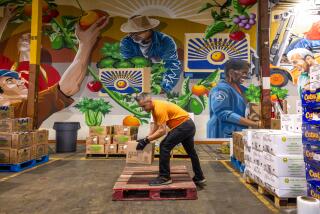Leftovers From Swank Hotels Feed India’s Poor : Food bank: Thousands of children feast on such delicacies as croissants, cashew pilaf and creamy lentil soup, thanks to an Indian doctor and an American engineer.
- Share via
NEW DELHI — As it rolled into the slum schoolyard, children shouted, “The blue van has come! The blue van has come!”
When the van had stopped, the children crowded inside, jostling, clutching stainless steel plates, finally obeying their teachers and sitting on the floor in a row. Volunteers scurried around the mobile kitchen, heating croissants, cashew pilaf, creamy lentil soup, potato curry.
Thousands of children whose families can afford only bread and water feast on such delicacies at least once a week, thanks to an American engineer of Indian descent and an Indian doctor who collect food from luxury hotels, caterers, airlines and factory cafeterias.
“We want to fight hunger and combat food wastage,” said Virender Kumar Bhalla, who started India’s first food bank four years ago after watching a television show about a soup kitchen in Washington, D.C.
Bhalla, who lives in Albertson, a town on New York’s Long Island, said it was the first anniversary of his mother’s death, an occasion many Hindus mark by feeding the poor for a day.
“I told my wife, ‘If in the U.S., which produces more food than anywhere else in the world, they take steps to reduce wastage, why not in India?’ ” Bhalla said. “We can feed thousands of people every day. It will be the best tribute to Mom.’ ”
His friend B. M. Abrol, a New Delhi surgeon who had been a visiting professor at Boston and Michigan State universities, offered to manage the project. Abrol told Bhalla he had wanted to help poor people since the 1950s, when he saw thousands of starving people during a famine in northern India.
After studying food banks in the United States, Bhalla flew to India and talked hoteliers into donating leftover food. The Agya Wanti Bhalla Food Bank, named for his mother, was born.
Bhalla bought two vans and financed the project for the first two years. Now donations have begun coming in from India and the United States.
Each morning, volunteers head out in the two blue vans to pick up the food and take it to orphanages, centers for handicapped students and public schools in slums. All day and well into the night, the vans crisscross the capital, picking up and delivering food.
All the food is tasted by donor kitchen staffs and volunteers.
“We don’t hand out anything that we ourselves wouldn’t eat,” saiK. Sibal, executive chef of the Hotel Ashok, where visiting presidents and prime ministers stay.
“All hotels cook more than needed,” he said. “We used to throw out at least 100 portions of perfectly good food every day, since we are not allowed to serve leftovers to our guests.”
The food bank has worked so well that volunteers have started a similar program in the southern city of Madras and another is planned in Bombay.
“We started with 50 people in New Delhi,” Abrol said. “Today we feed 2,000. By December it will be 5,000, by the end of the decade 15,000.”
He hopes to extend the program to villages in a project called Mushtidaan. Participants will be encouraged to set aside a fistful of rice, wheat or lentils every day and donate the food to a community kitchen at the end of each month.
“A fistful of grain can help end hunger in India,” Abrol said.
More to Read
Sign up for Essential California
The most important California stories and recommendations in your inbox every morning.
You may occasionally receive promotional content from the Los Angeles Times.













